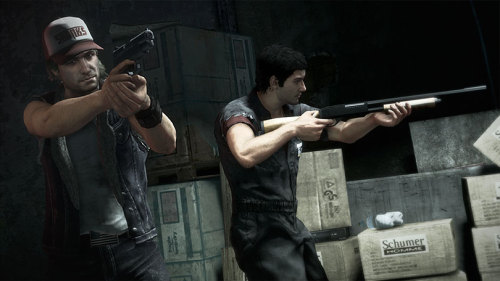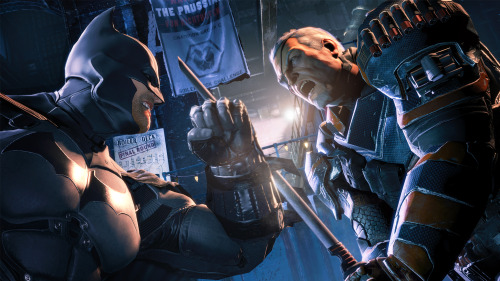It sometimes feels as though the debate surrounding games as art is forever stuck in a cyclical mire. For every game that indicates some transcendent shift toward the artistic, several more insist on dragging it, kicking and screaming, back to disposable hobby territory. Though this cycle may seem frustratingly rote, maybe the process of advancement toward art form can better be observed through the processes of development, rather than the final (and singular) output of any given development cycle. As I write this, Batman: Arkham Origins is sneaking its way into stores, and no doubt, many millions of PS3s and X360s. With it though comes not just the excitement of a new installment in a beloved franchise, but also trepidation carried by the widely acknowledged shift in development duties from series custodians Rocksteady, to previously little known studio WB Montreal.
A cursory glance at the current review scores seem to indicate that, as many probably suspected, the game in some ways fails to meet what series fans want or expect. Perhaps more interestingly though, is the general consensus that the game seems to, at least on a technical level, be as sturdy as anything that Rocksteady delivered during the campaigns of Arkham Asylum, and subsequently, Arkham City. So where then does Arkham Origins stumble? A good starting point to look then would seem to be the creative aspects of the game. Several review sources indicate that many of the little touches Rocksteady imbued the previous game with are absent, making traversal of the new game's open-world seem less inviting.
This does in fact seem an odd thing to quibble over, if as it implies, little touches, are indeed so little. If you played Arkham Asylum for instance, when you moved through the G.C.P.D morgue, did you get to see Ra's al Ghul's 'dead' body? Maybe you did, maybe you didn't. It doesn't add anything to the game's greater narrative. The kicker though, is that if you did see it, you more than likely noticed later that the body was gone when you traveled back through the same room. So other than the creative nod to D.C's larger universe, does it matter that Rocksteady added something so small, or even changed the easter egg part way through the game? Ultimately, no, it doesn't, but it does profoundly alter the textural richness of the game.
As such, it is here that our beloved hobby of gaming, if not yet ready to fully be embraced as art, is certainly beginning to (in some curious ways) parallel one of its greatest banes - imitation. Now, to clarify, I'll make no attempt to talk about Company A, imitating Company B's game - that's not the point. It has also been talked to death, by gamers and media alike. Instead, I'm talking about imitation born of a company attempting to succeed its own product. The accelerated development processes of which are increasingly seen as robbing our games of texture, while still being able to deliver technically proficient (even superior) facsimiles of our franchise expectations. Yet, in spite of the fact the games we are seeing are maintaining technical cohesion, often (and arguably necessarily), they are offering diminishing returns creatively.
To strike a parallel in the world of art forgeries, a copy will often contain several elements which an artist is known for, in order to be considered either a previously unseen work, or a rare prior version of a famous work. In essence, a composite containing enough artistic dna to recall to mind the work of an original master. It is this very dynamic which is now beginning to impact the games we love. A new franchise game might be technically proficient enough, and contain enough creative dna to be representative of what has come before without profoundly understanding the entirety of depth and nuance that a series lives or dies by.
Is the newest Batman game a travesty then? No, not even close. In fact, it seems to have been quite warmly received. However, much of the praise it is receiving pivots on the fact that it contains the elements you expect, but doesn't contain the confident brush strokes of its true creator. It has done then what it should, as opposed to what it could. It has largely convinced people it is a fun Batman Arkham game worth picking up - it has an impressive and verifiable provenance, but it is not a master work.
Of course, it is not entirely the fault of the developers that the game seems to have fallen arguably short. No creative endeavor is intended to be lacking, but there is a cautionary tale here. Games are not the sum of their technological parts. Game engines, physics, rendering pipelines, they are no more than a fitting canvas upon which to lay out the intended work. Convincing gamers that a game is special takes more than that. In a game built with confidence, the prevalence of the little details is of the greatest importance. They can be the difference between a masterpiece and a competent, though somewhat clinical, imitation.
A cursory glance at the current review scores seem to indicate that, as many probably suspected, the game in some ways fails to meet what series fans want or expect. Perhaps more interestingly though, is the general consensus that the game seems to, at least on a technical level, be as sturdy as anything that Rocksteady delivered during the campaigns of Arkham Asylum, and subsequently, Arkham City. So where then does Arkham Origins stumble? A good starting point to look then would seem to be the creative aspects of the game. Several review sources indicate that many of the little touches Rocksteady imbued the previous game with are absent, making traversal of the new game's open-world seem less inviting.
This does in fact seem an odd thing to quibble over, if as it implies, little touches, are indeed so little. If you played Arkham Asylum for instance, when you moved through the G.C.P.D morgue, did you get to see Ra's al Ghul's 'dead' body? Maybe you did, maybe you didn't. It doesn't add anything to the game's greater narrative. The kicker though, is that if you did see it, you more than likely noticed later that the body was gone when you traveled back through the same room. So other than the creative nod to D.C's larger universe, does it matter that Rocksteady added something so small, or even changed the easter egg part way through the game? Ultimately, no, it doesn't, but it does profoundly alter the textural richness of the game.
As such, it is here that our beloved hobby of gaming, if not yet ready to fully be embraced as art, is certainly beginning to (in some curious ways) parallel one of its greatest banes - imitation. Now, to clarify, I'll make no attempt to talk about Company A, imitating Company B's game - that's not the point. It has also been talked to death, by gamers and media alike. Instead, I'm talking about imitation born of a company attempting to succeed its own product. The accelerated development processes of which are increasingly seen as robbing our games of texture, while still being able to deliver technically proficient (even superior) facsimiles of our franchise expectations. Yet, in spite of the fact the games we are seeing are maintaining technical cohesion, often (and arguably necessarily), they are offering diminishing returns creatively.
To strike a parallel in the world of art forgeries, a copy will often contain several elements which an artist is known for, in order to be considered either a previously unseen work, or a rare prior version of a famous work. In essence, a composite containing enough artistic dna to recall to mind the work of an original master. It is this very dynamic which is now beginning to impact the games we love. A new franchise game might be technically proficient enough, and contain enough creative dna to be representative of what has come before without profoundly understanding the entirety of depth and nuance that a series lives or dies by.
Is the newest Batman game a travesty then? No, not even close. In fact, it seems to have been quite warmly received. However, much of the praise it is receiving pivots on the fact that it contains the elements you expect, but doesn't contain the confident brush strokes of its true creator. It has done then what it should, as opposed to what it could. It has largely convinced people it is a fun Batman Arkham game worth picking up - it has an impressive and verifiable provenance, but it is not a master work.
Of course, it is not entirely the fault of the developers that the game seems to have fallen arguably short. No creative endeavor is intended to be lacking, but there is a cautionary tale here. Games are not the sum of their technological parts. Game engines, physics, rendering pipelines, they are no more than a fitting canvas upon which to lay out the intended work. Convincing gamers that a game is special takes more than that. In a game built with confidence, the prevalence of the little details is of the greatest importance. They can be the difference between a masterpiece and a competent, though somewhat clinical, imitation.




